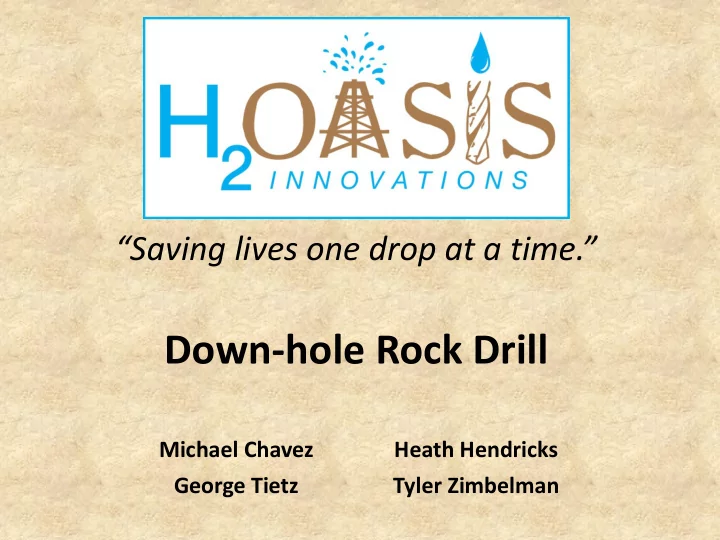

“Saving lives one drop at a time.” Down-hole Rock Drill Michael Chavez Heath Hendricks George Tietz Tyler Zimbelman
Overview • Water4/Problem Statement • Client Requirements • Obstacles and Current Designs • Objective January 1 st Designs • • Preliminary Testing • Final Design/Associated Tasks • Problems • Drawings • Testing • Financial Analysis • Future Work
• The Water4 Foundation is a public charity based out of Oklahoma City, Oklahoma. • Founded by Dick and Terri Greenly. • https://water4.org/media/ https://water4.org/about-us/
Problem • Consolidated rock layers within the borehole impede the water well drilling system from completion. • Workers are left with either digging out the rock with hand tools or breaking through the layer using a cable tool system. • These methods take days to remove the rock layer before workers can continue drilling.
Objective • Design a rock drilling system for water wells. • Design budget is initially set at $25,000
Client Requirements • “Hot Shot” Crew • Truck mounted unit independent of current methods • Multiple holes can be drilled daily
Client Requirements • Must drill through material as dense as quartzite • Quick trips in and out of borehole. • Maximum depth of 150 feet • Easily Operable Quartzite • Able to be transported in 7 on Mohs Hardness scale rough terrain.
Obstacles
Design: Progressive Cavity Motor with Coiled Tubing • Fluid power to progressive cavity motor via coiled tubing. • Coiled tubing provides quick trips in and out of hole. Progressive Cavity Motor
Key Component: Progressive Cavity Motor • http://www.youtube.com/ watch?v=jRC_O7hQBgc
Initial Design Drawing
Sub-Design 1 : Closed-loop hydraulic power • Features a down-hole progressive cavity motor to spin a bit at the rock surface. • Motor is attached to coiled tubing at the top surface. • Hydraulic fluid is pumped through the tubing to power the motor for drilling. The fluid returns in hydraulic hose to surface and is recirculated in system.
Sub-Design 2 : Water power exhausted at bit • Features a down-hole progressive cavity motor to spin a bit at the rock surface. • Motor is attached to coiled tubing at the top surface. • Fluid medium is pumped through the power section for drilling, lubrication, and cuttings removal.
Preliminary Testing for Design Selection • Thru-Tubing Solutions – Longview, TX: Flow rates affecting torque capabilities. – Elk City, OK: Penetration rates through chert rock found using flow rates found in Longview. • Progressive Cavity Motors Used – 2- 1/8’’ and 2 - 7/8’’ OD
Thru Tubing Solutions Longview, TX • Goal – Determine the following.. • Maximum flow rate • Maximum pressure • Stall point
2-1/8" Roper Performance Trendline 1200 Pressure (PSIG) Pressure (psi), Speed (RPM), Torque (ft-lbs) Speed (RPM) 1000 Torque (LB-FT) 800 600 400 200 0 5 10 15 20 25 30 40 50 Flow (GPM)
2-7/8" SpiroStar / Hemi Performance Trendline 2000 Pressure 1800 Speed Pressure (psi), Speed (RPM), Torque (ft-lbs) 1600 Torque 1400 1200 1000 800 600 400 200 0 10 15 20 25 30 40 50 Flow (GPM)
Elk City Testing • Testing of penetrations rates using 700 lbs of force • Tested with 25 GPM • Items tested 1. 2- 1/8’’ and 2 - 7/8’’ Motor 2. 3 drill bits (Tri-cone, button, reverse-clutch)
Drill Bits Tri-Cone Button Reverse-clutch
2-1/8'' Motor Penetration Rates 3.5 3 Penetration (inches) 2.5 2 Roller Cone 1.5 Reverse Clutch 1 Bear Claw 0.5 0 0 10 20 30 40 50 Time (min) 2-7/8'' Motor Penetration Rates 9 8 7 6 Penetration (inches) 5 Roller Cone 4 bear claw 3 Reverse Clutch 2 1 0 0 5 10 15 20 25 30 35 Time (min)
Finalized Design (Demo Unit) • Closed-loop hydraulic system controlling two motors. • 1.69’’ down -hole motor attached to kevlar tubing. • Hydraulically controlled hose reel.
Main Tasks • Progressive Cavity Motor Modifications – Hydraulic return line needed • Support Frame – Vertical support of down-hole motor • Hydraulic Power Unit – Engine, pump, valves, and reservoir • Reel Stand – Support rotating coiled tubing – Transport hydraulic fluid
Challenges with Down-Hole Motor • Recirculating fluid to surface – Return line must be protected – Custom fabrication needed (Thru Tubing) – Efficiency (hose size) – Bit size increases with hose size
Progressive Cavity Modification Drawing
Progressive Cavity Modification
Telescoping Support Drawing
Telescoping Support
Challenges with Hydraulics • 18 HP engine • Hydraulic motor sizing – Large radius of reel combined with 300 lb load – High torque vs low RPM required (3:1 reduction) • High flow vs low pressure and low flow vs high pressure in hydraulic system – 30:70 Flow control valve
Hydraulic Schematic
Hydraulic System
Reel Stand Drawing
Reel Stand
Flatbed Assembly Drawing
Flatbed Assembly
Testing • Proof of concept • Demo Application
Financial Analysis • $25,000 Budget • Material cost totaled: $19,172* • Donations: Hydraquip Distribution, Thru Tubing
Future Work • Improve penetration – Upscale of Demo – Add weight down-hole – 2- 1/8’’ or 2 - 7/8’’ progressive cavity motor – Larger engine and pump for more flow – Modification to auger and drill simultaneously
Acknowledgments • Wayne Kiner • Dr. Paul Weckler • Water4 Foundation • ThruTubing Solutions • Hydraquip Distribution • Biosystems Shop and Crew • Dr. James Hardin • Dr. James Puckette • Dr. Peter Clark
Questions?
Recommend
More recommend